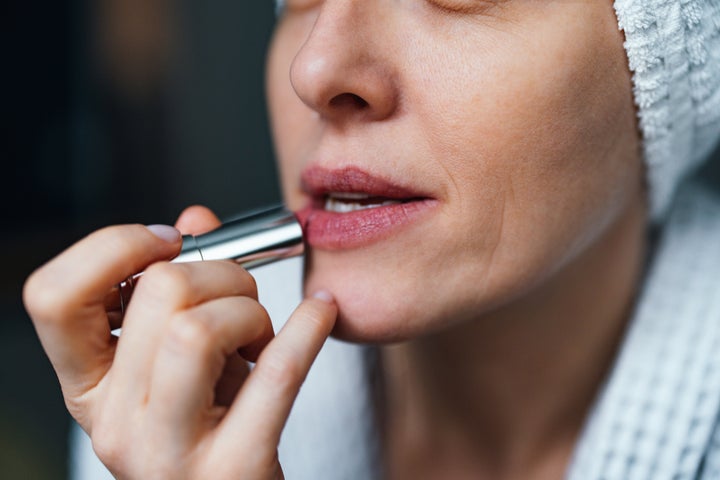
Remember when you used to slap on a coat of lipstick as you dashed out the door — and still managed to look great? If you’re anywhere north of 50, it’s likely those days are over.
You may have already noticed how lipstick tends to run into even the finest lines around your mouth, leaving you with a smeary mess that can’t be blotted away with tissues.
Fortunately, there are smart, savvy makeup artists who have shared their expertise with us. They offered some insight on why our lipstick seems to suddenly turn on us.
Michelle Wong, the cosmetic chemist behind the popular site Lab Muffin, said: “As you get older, your skin tends to thin and develop more lines and furrows, which act as ‘channels’ for lipstick, which has pigments that are slightly soluble in the product’s oils.”’
Is there an official name for this new indignity? “It’s called lipstick ‘feathering,’ because instead of a sharp, crisp line around the lips, it can look like a feather around the edges — a bit soft and never defined,” explained makeup artist Mila Thomas.
What to avoid: formulas that are wet, thick and glossy.
After all those years of aiming for moist, glossy lips, you’re going to need to transition away from those types of products. “Oily, liquid lip products are more prone to feathering,” Wong said. “Lip glosses applied on top of lipsticks are common culprits.”
Makeup artist Jamie Greenberg said that matte products might be a better fit for an older cosmetics user. “Anything too wet, glossy or thick will make the problem worse,” she said.
Thomas explained the reason why: “If the formula is too wet, it will more easily bleed into the skin beyond the lip line.”
Yes, you need to ‘prep’ your lips now.
There are techniques to avoid out-of-control pigment from spreading all over your face. But you’ll need to do a little pre-work before applying your favorite lippy.
It’s going to take some trial and error as you experiment with products and application methods. “I know it’s super-annoying, but there’s a technique out there for everyone,” said Jeanine Lobell, makeup artist and founder of the Neen cosmetics brand.

“It can help to exfoliate the lips daily, and to use lip balm each day to keep lips smooth,” Thomas said. Greenberg suggested using a lip scrub on and above the lips, too. If you want to do even more to set your lips up for success, she suggested using a nighttime lip mask.
How to apply smudge-free lipstick:
Now that you’re exfoliated, balmed and masked, here’s how to apply lipstick so it stays where you put it.
Start with a mattifier/filler. “Put it on the lip line, going on the skin and in the outer corners,” Lobell said.
Apply lip-filling primer to smooth skin and create a barrier between your lipstick and any natural oils.
Brush on lip stain for a long-lasting colour base.
Outline: Greenberg recommended lining lips with a flesh-toned concealer or lip pencil to create a barrier between the lipstick and the fine lines around your lips.
Lobell outlined the process she uses: “Fill in the lip line, overdrawing very slightly. It’s very important not to draw all the way to the outer corner, because stopping a little short of the lip line is more flattering. Once you’ve applied liner, even if your lip colour migrates, it will be held in place by the liner.”
Brush on lipstick: Greenburg uses a lip brush instead of applying the lipstick directly. “Brush out from the pout of your lips outwards,” she advised.
Blot: Thomas said, “Take a tissue and split it apart so it’s only one-ply. After you apply one coat of lipstick, lightly blot lips with the tissue.”
Add another coat: “The two-coat layering technique, with blotting in between, will make the colour more long-lasting and help it stay in place,” Greenberg explained,
Finally, a bit of powder: “Dab the entire lip area with a bit of translucent powder and you should be ready to go,” Greenberg said.
What are the best lip products to buy?
“Use a more matte long-wear colour for better control,” Lobell said. “A matte lipstick that’s full-coverage with a smudge-resistant finish is going to ‘travel’ less than other formulas.”
Still craving a bit of shine? “Keep gloss away from the edges of your lips, and apply it sparingly,” Wong said.
“If you need your gloss, keep it more centred on the lips when you apply it, tap lips together, and allow the extra to make it evenly shiny,” Lobell said. “If you love a creamy formula, tap the lips with blotting paper after you apply it.”